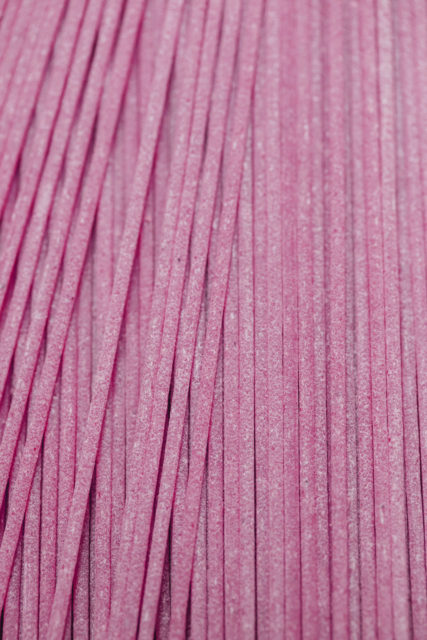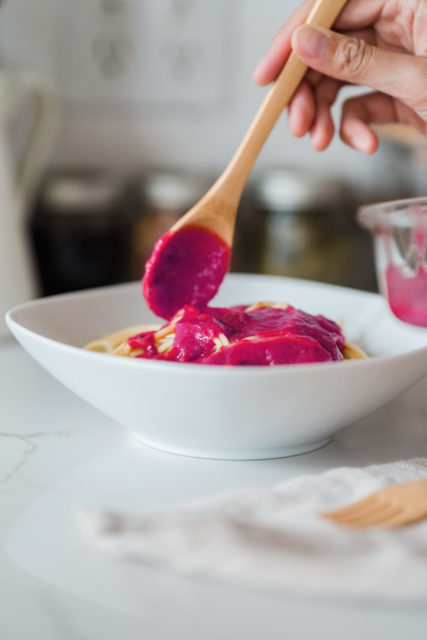I don’t know about you, but for some time I was a firm believer in putting grated cheese over pasta, any pasta, always.
The truth is adding cheese to pasta is not always advised in Italian tradition, it all depends on the sauce. On some sauces, like Bolognese and Carbonara, it is usually accepted to add some grated cheese before eating, but for many other sauces it’s more a matter of taste, and manners.
See, in traditional Italian cooking a pasta sauce takes hours to cook, and the recipes are perfected over the years, through generations. When preparing a dish of pasta Italians are actually setting the base to enjoy the sauce, and adding cheese to the mix, just because, could totally throw off the balance of the ingredients.
So if you are ever in Italy or around Italian people, the polite thing is to only add cheese to your dish if offered some. The idea is that the waiter or host will know if the sauce you are about to taste goes well with cheese or not, and offer it to you accordingly. At the very least try your pasta as it comes to you first, and then ask for cheese if you really think it needs some, kind of like you would do with salt.
Ok, now that we know the basics about putting cheese on pasta, let’s take a look at the different types of cheese that can go well with pasta, where do they come from and in which cultures they are used.
What cheese do the Italians put on their pasta?
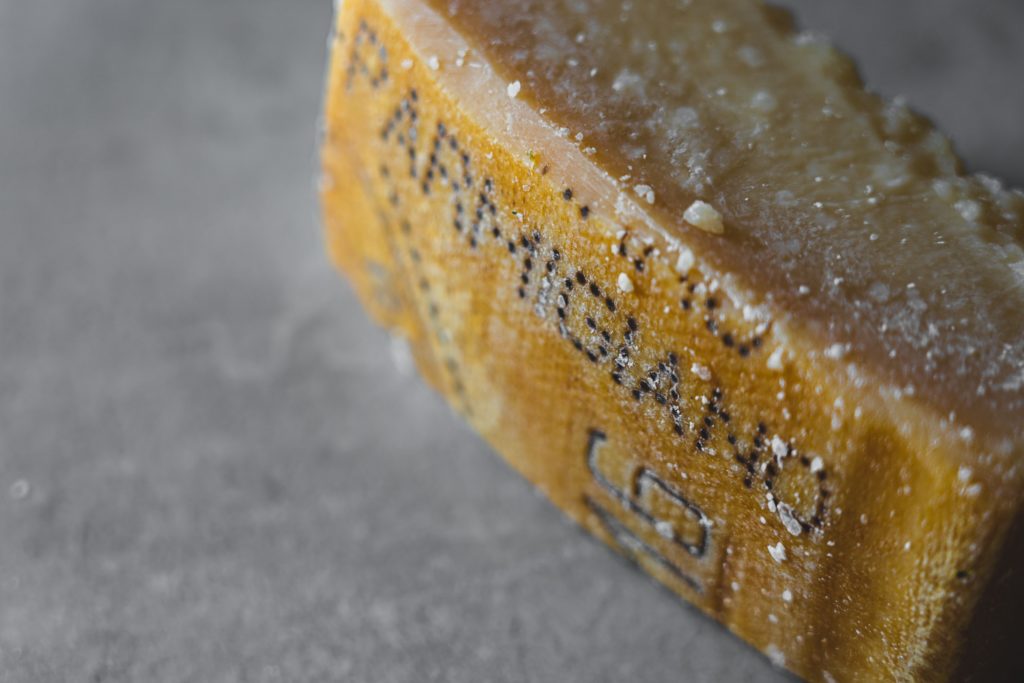
When Italians add cheese to their pasta, that will almost always be Parmigiano-Reggiano, also known as Parmesan cheese. This cheese is made from cow’s milk and has a hard, granular texture. It is aged for at least two years and has a sharp, nutty flavor. Other types of cheeses that are commonly used in Italian pasta dishes include Pecorino Romano and Grana Padano.
There are regional variations or course. For example, in Piedmont, located at the north of Italy and sharing borders with France and Switzerland, you might find that gorgonzola is sometimes used on pasta instead of parmesan.
What about Cheddar, Emmental or Gruyere?
Depending on where you are from, you might be used to adding other types of cheese to your pasta, and might even think that the cheese you are used to is the “traditional” one. But don’t you dare tell that to an Italian!
I remember visiting an Italian restaurant once with a native Italian friend. When taking our order the waiter asked my friend “would you like some cheese on your pasta?”, to which my friend replied “sure!”. The waiter went on to asking “which cheese would you like?”. My friend then replied “what do you mean?”. The waiter very politely explained that they could add parmesan cheese or Emmental cheese to her order. I will never forget my friend’s face, confused, when she very calmly told the waiter “you do not put Emmental on pasta, that is wrong!”.
Well, as we’ve already seen parmesan (or similar) is the way to go according to Italian tradition, but one of the things that makes pasta unique and so successful is its adaptability, and different cultures have definitely taken advantage of this fact to make pasta a little bit more their own by pairing it with other types of cheese.
Emmental cheese on pasta
Spain is known to use Emmental cheese on their pasta (now you know where the previous story happened).
This comes from other traditional dishes which use pasta and gratin cheese on top, that cheese often being Emmental. The Spanish assumed if Emmental cheese went well with pasta gratin it would also go well with non-gratin pasta.
Gruyere cheese on pasta
Very similarly, in France, it is common to add grated Gruyere cheese on top of pasta dishes such as quiche and gratins. And once again, if it pairs well in one dish why wouldn’t it go well simply grated over pasta, right?
Feta cheese on pasta
You’ve probably guess which country we are going to be mentioning next. Greece! The Greeks have their very unique family of cheeses, feta being one of the most widely used. It was only a matter of time before someone decided to try it on pasta, and the truth is it can go quite well with some pasta dishes, specially those with simple sauces or no sauce at all, just a little bit of virgin olive oil, some vegetables and feta cheese.
Actually, a very easy pasta with feta cheese recipe recently went viral on social media, If you haven’t tried it yourself you probably at least heard about it. This is how it came out for some of the people who gave it a try.
Cheddar cheese on pasta
Cheddar cheese is not as common to find in Europe. It originally comes from the British Isles, and it is commonly added to macaroni and cheese in the United States.
Now you know that adding cheese to your pasta is not to be taken lightly, and if you do you know what your options are and who will love you or judge for it!
Whichever cheese you choose… Buon appetito!
We all know that pink is the new black, and pasta is the new Rockstar of the culinary world. So when you put them together, you get an amazing dish that’s not only delicious, but also Instagramable! In this post we are going to be talking about pink pasta. What’s all the buzz around it? Is it any good? Is it healthy? How do you make it?
As our cooking becomes more creative chefs and amateurs around the globe are trying to spin traditional recipes into something new, something delicious, something surprising… and why not, something that can go viral on social media as well!
What’s all the buzz around pink pasta?
One thing that makes pasta unique is it’s adaptability. Recipes are relatively simple to evolve without loosing it’s essence. It has been done for centuries, and we certainly were not going to stop now!
Pink pasta is one of these new spins on traditional recipes. The dish is currently trending and gaining popularity, thank in part to social media. The beautiful color of this dish is what makes it so popular on Instagram. But it’s not all just about looks, it’s also delicious! It’s distinctive color usually comes from beetroot (not always though, some people use food coloring too), which sweetness also pairs perfectly with the savory flavors of cheese and tomato sauce.
When you think about it, pink pasta is a tasty, healthy and visually impacting dish, a perfect recipe for virality in today’s world! Here you can see just a few examples of influencers posting their pics of pink pasta on social media. Who wouldn’t stop if this post showed up in your feed!
Is pink pasta healthy?
Within the world of pasta, yes, pink pasta can be considered healthy, and in most cases also vegetarian and vegan.
As we mentioned before, the beautiful color of this dish usually comes from beetroot. Beetroots are an excellent source of fiber, vitamins, and minerals. They’re also low in calories and fat. So pink pasta made with beetroot is a healthy option if you’re looking for a lighter dish.
Beetroot is a vegan food, and as we mentioned before, it’s usually what gives pink pasta its color, so when you add beetroot to any already vegan pasta dough recipe or sauce recipes, the result still remains began. Just be careful if you are using pre-processed products in your recipe. Some tomato sauces for example may contain dairy products and even animal-based ingredients, so always make sure to check the label of these products to make sure your dish remains 100% vegan.
Ways to make pink pasta?
There are two ways to make pink pasta, you can either add beetroot to the dough or use it to make a pink sauce.
If you want to add beetroot to the dough, you need to cook the beetroots first. Boil them until they’re soft enough to mash. Once they’re cooked, mash them and add them to the dough along with the other ingredients. That’s the basic idea, but if you want to make your own pink pasta dough we recommend you follow our recipe here:
If you want to make a pink sauce, you need to cook the beetroots and then blend them until you have a smooth sauce. Then add the pink sauce to your pasta dish once it’s cooked. Again, that’s just to understand how the sauce becomes pink, but if you want to try it yourself, be sure to check our recipe for pink pasta sauce, where you will find all the ingredients and steps in more detail.
Have you tried pink pasta? What did you think? Let us know in the comments below!
If you are a pasta fan, then you should definitely know the difference between the most popular long-shaped pastas: spaghetti, linguine, fettuccine, bucatini… Even though they all look similar, there are some subtle differences that can make a big impact on your dish.
If this hasn’t happened to you, you probably have seen it happen at the table next to yours sometime. It is not uncommon to go to an Italian restaurant, order a dish, and find yourself having to ask the waiter if that’s the correct order when the plate arrives to the table. With so many pasta shapes available it’s easy to get confused!
In this blog post, we will take a closer look at each of these types of pasta and show you how to tell them apart. So that next time you are ordering your favorite dish at an Italian restaurant or cooking it at home, you will be able to identify the right type of pasta every time!
Spaghetti
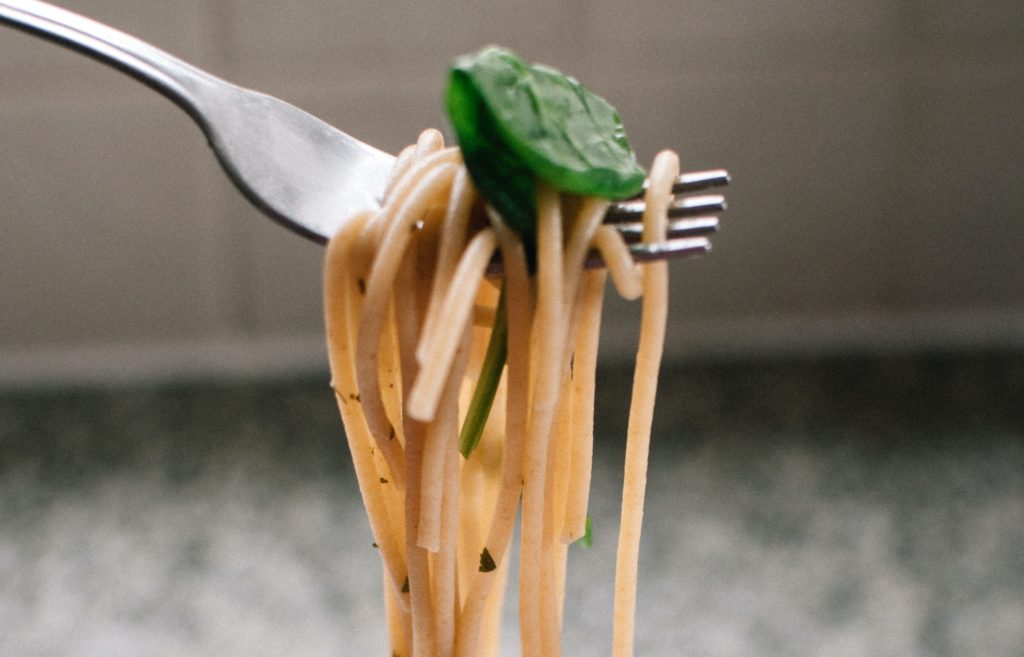
Spaghetti is the most well-known type of long pasta. It is made from a thin, round dough that is extruded through a die to create long, thin strands. If made even thinner, spaghetti can also turn into another type of pasta known as “capellini”.
Spaghetti pairs well with light sauces or vegetables and can be used in a variety of dishes, warm and cold.
Bucatini
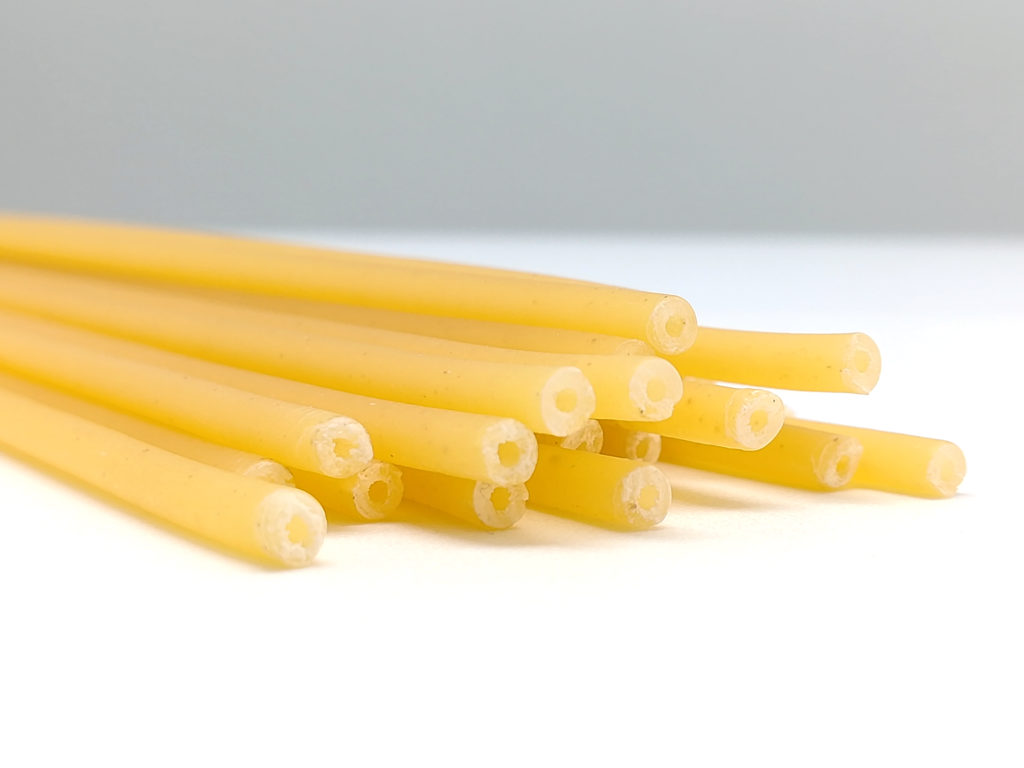
Bucatini is another type of long pasta that is similar in appearance to spaghetti, but thicker. It is made from a hollow dough that is extruded through a die to create long, hollow strands. It is literally like a thick spaghetti with a whole through the middle. There is an even thicker version of bucatini which is called “Maccheroncini”.
Each bucatini already has a lot of pasta in it, so it is usually paired with lighter lighter sauces or served in smaller portions.
Linguine
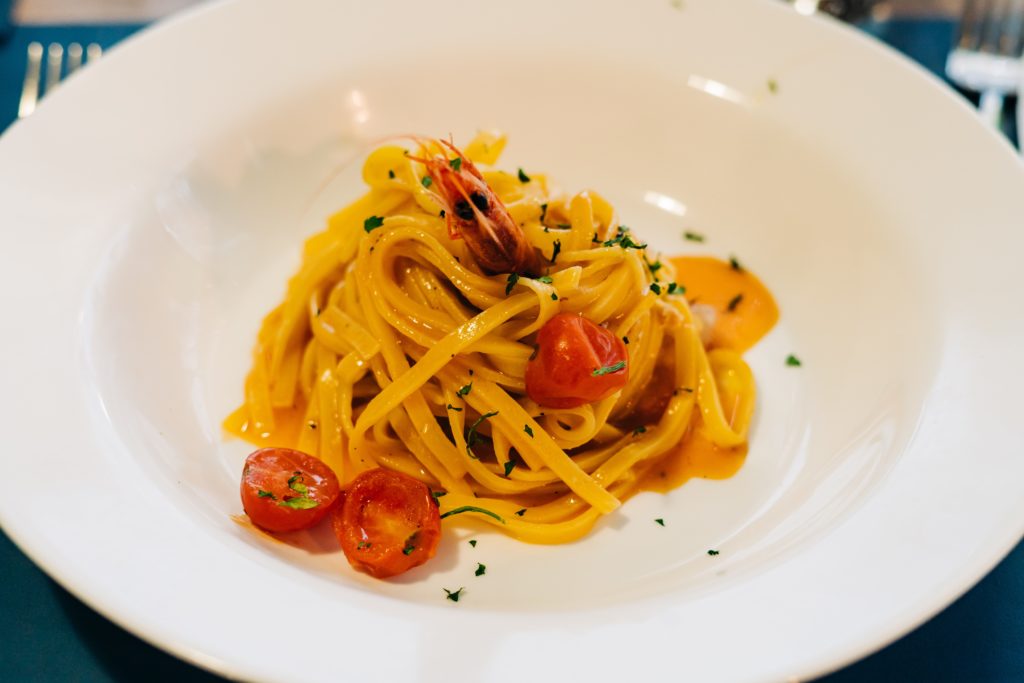
Linguine is another type of long pasta that is similar in appearance to spaghetti. However, it is made from a flattened dough that is extruded through a die to create long, flat strands. From all the types of flat-long pasta (and we will see some of those in just a moment), linguine is the thinnest one possible, kind of like a flattened spaghetti.
Linguine usually pairs well with heavier sauces .
Fettuccine
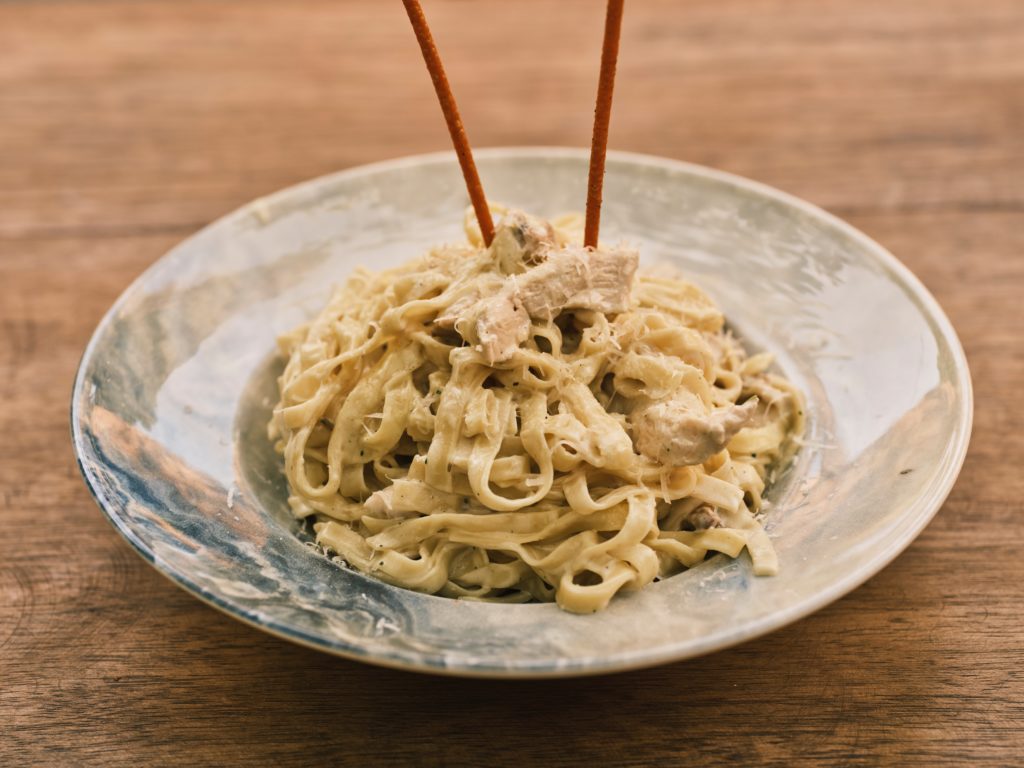
Fettuccine is another type of long-flat pasta that is similar in appearance to spaghetti and linguine. However, it is made from a wider dough (around 4-6mm). Traditional fettuccine is not extruded like spaghetti or linguine, instead it is cut from a flat sheet of pasta.
Fettuccine pairs well with heavier sauces and is probably known by everyone because of the famous pairing “Fettuccine Alfredo”.
Tagliatelle
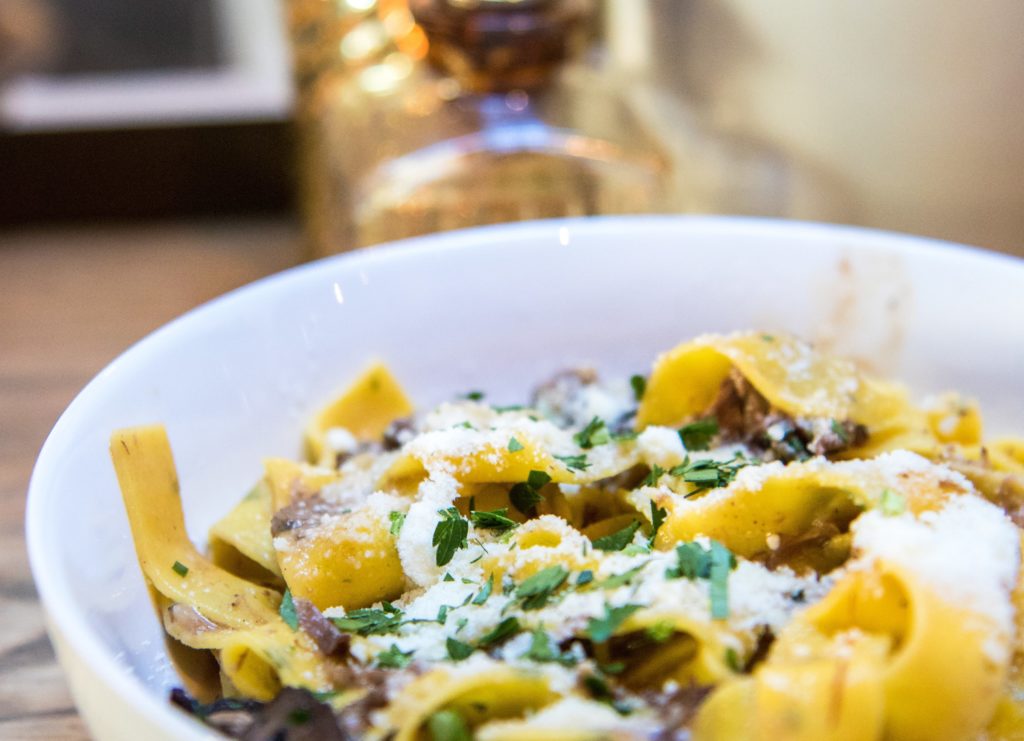
Tagliatelle is the next type of long-flat pasta that is similar in appearance to fettuccine. However, it is made from a thinner dough (around 0.65-0.80mm) and is slightly wider (up to 10mm). Just like fettuccine, tagliatelle is too wide to be extruded, so instead it’s cut out from a flat sheet of pasta.
Tagliatelle pairs well with meat-based sauces or vegetables.
Pappardelle
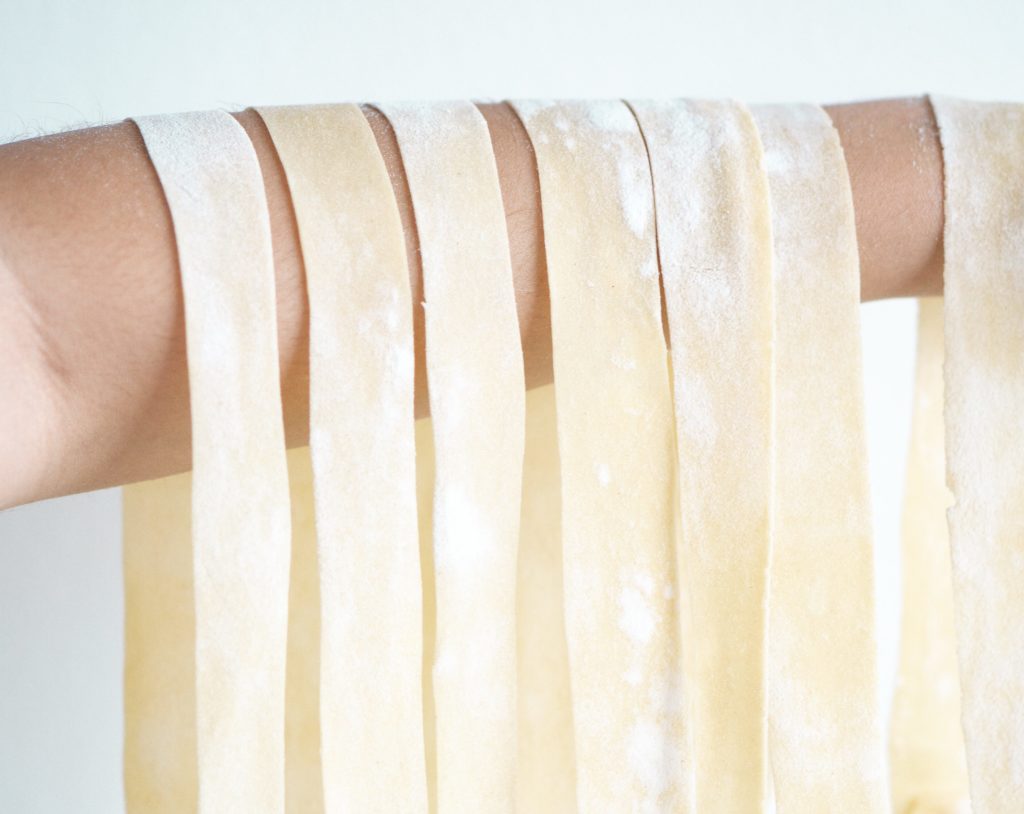
Pappardelle is… did you guess it? That’s right! Pappardelle is just like tagliatelle but wider. Pappardelle can be up to 30mm wide, making it the widest withing the family of long-flat pastas.
Pappardelle is usually served with hearty, meat-based sauces.
Mafaldine
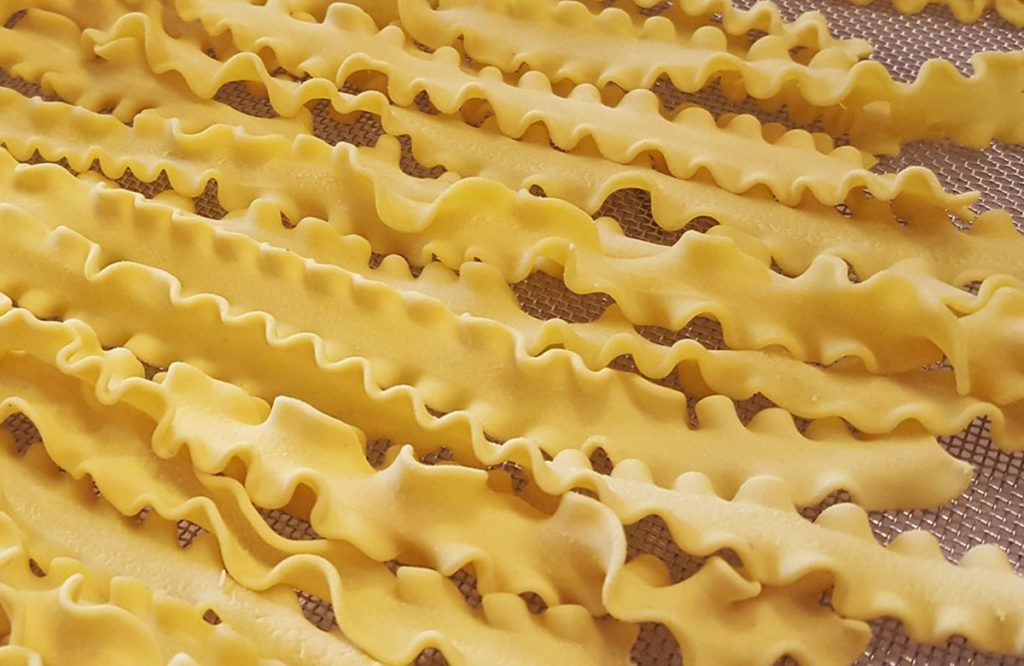
We’ve saved one of the most unique types of long pasta for last. Mafaldine is yet another type of long-flat pasta, which can vary in width from 6mm to 15 mm. The detail that makes mafaldine unique, and very easy to tell apart from all the other shapes of pasta, is that the sides of each mafaldine are wavy, like the bottom of a women’s skirt.
The name “mafaldine” actually comes from a princess called “Mafalda of Savoy”, who was very tall and slender, and who’s lacy dressed inspired the shape of this pasta (or so the story tells). Actually, mafaldine is also known as “reginette”, which in Italian means “little princess”.
It woudn’t be possible to achieve the ruffled edges starting from a flat sheet of pasta, so mafaldine is one of the widest types of pasta to be extruded, traditionally through bronze dies.
Now that you know the difference between all these types of long pasta, you will be able to order or cook your favorite dish with the right type of pasta every time! So, the next time you are at an Italian restaurant or cooking at home, be sure to remember these!
Buon appetito! (That means “enjoy your meal” in Italian!)
Dry pasta, like any other food you can buy at the grocery store, has an expiration date. You might have even thrown out some perfectly good dry pasta just because it was past its expiration date. But would it really have been dangerous to eat them? The truth is if you ask your parents or grand parents, they’ll tell you that many products had a way longer shelf life when they were young than they do now, and that is particularly true for dry pasta. For centuries dry pasta didn’t even have an expiration date! Can you imagine that?
So, were our parents and grandparents really eating spoiled food that might have been bad for them? Or are brands and regulators playing it way to safe today, setting shorter shelf-life dates for products such as dry pasta, just to be on the safe side and protect themselves from any liabilities?
There is no easy answer to this question, but we can try to look at it from a few different angles. Let’s start with the history of pasta and see how long it typically lasts. Then we’ll explore what might cause it to go bad and whether there are any health risks associated with eating expired noodles. Finally, we’ll give you our opinion on whether you should pay attention to those expiration dates or not.
History of pasta
Pasta is a food that has been around for centuries, and its shelf life used to be a lot longer than it is today. In fact, until the early 20th century, there was no such thing as an expiration date for dry pasta! It was only when mass production and processing of food became more common that expiration dates started to appear on products.
The truth is, the concept of an expiration date is a relatively new one, and it’s not always an accurate indicator of when a food actually goes bad. The main reason expiration dates exist is for food safety. But there are other factors that can affect the safety of food, such as how it’s stored, whether it’s been contaminated, and so on. So always keep these two sides of the coin in mind:
- Just because a food has an expiration date that’s sometime in the future, doesn’t necessarily mean it’s safe to eat, it might have gone bad before it’s expiration date for a number of reasons, which we will go into more detail in just a minute.
- The same way if you have a package of dry pasta that is over it’s expiration date, it doesn’t necessarily mean it’s has gone bad. It probably is still perfectly safe to eat if it has been properly store and shows no signs of deterioration.
What causes pasta to go bad?
There are two main things that can cause pasta to go bad, sometimes even before it’s advertised expiration date: moisture and oxygen.
Moisture is the main enemy of dry pasta. When pasta are stored in a humid environment, it can start to grow mold or mildew.
Oxygen can also cause pasta to go bad. When pasta are exposed to oxygen it begins to oxidize and turn brown.
So, if pasta is stored in a humid or wet environment, or if it’s exposed to oxygen, it can go bad, even before its expiration date.
How should dry pasta be stored to last longer?
A factor that is key to guaranty that dry pasta lasts until it’s advertised expiration date or longer is the way it’s stored. Pasta that’s stored in a cool, dry place will last longer than pasta that’s stored in a warm, humid environment.
This is why most brand these days opt for hermetic packaging options that help guaranty the preservation of the product in optimal conditions, without being exposed or affected by external factors.
It is also worth mentioning that even within dry pasta, there are some types that are easier to store than others. For example, generally speaking, whole wheat pasta tends to last longer than white flour pasta.
So, now that we know what affects the shelf life of pasta, let’s take a look at the health risks associated with eating expired noodles.
What are there health risks associated with eating expired pasta?
Generally speaking, the biggest risk associated with eating expired pasta is food poisoning. Pasta that’s gone bad can contain harmful bacteria that can cause vomiting, diarrhea, and other symptoms of food poisoning. It can also contain toxins that can be harmful to your health, even without making you sick. Remember, our grand parents might have eaten pasta that we would have considered expired just fine, but the life expectancy was also shorter in the early 20th century, so as imperfect as expiration dates might be, eating spoiled food is a real danger for our health.
In some cases, expired pasta can also cause allergic reactions. So, if you’re allergic to mold or mildew, you should be extra careful.
So, how do I tell if my dry pasta is good to eat or not?
The first thing we want to make clear is you should always pay attention to the expiration date on you pasta box (and any other food you are about to cook/eat for that matter). But like we’ve seen before, the fact that something is not expired doesn’t 100% guaranty it hasn’t gone bad, the same way if your pasta box is over it’s expiration date it might still be perfectly fine to eat.
Performing a quick visual examination of the pasta before cooking is always a good idea and will reinsure you about quality and state of the food you are about to it.
In the case of pasta these are some things you should be keeping an eye out for:
- After opening your pasta container, let it air for 5 to 10 minutes and smell it. If bacteria has started to develop you will smell a rancid scent.
- Look for changes in color. Your dry pasta’s colors should be uniform. If the edges have started to become darker that pasta probably isn’t good to eat anymore. And eve if it was it’s flavor and texture might be all wrong.
- Look out for mold spots. If the mold is advanced you will see green distinctive green spots. If the most isn’t too advanced you might only be able to spot tiny thin white hairs on your pasta, like if they were covered in velvet. In both cases that pasta is NOT safe to eat and you should through it away.
If you dry pasta is past it’s expiration date but does not show any of the symptoms listed above, it is probably still good and perfectly safe to eat.
Conclusion
For centuries dry pasta was considered to have a virtually infinite shelf life if properly stored. Now most brand these days set an expiration date for dry pasta of 1-2 years… Science has evolved a lot in the past 50 years, and safety regulations that follow that science have been set in place for our own good, but it is impossible for regulations to be perfect and contemplate every particular case.
Dry pasta is one of those cases where the regulation is on the safe side and probably too strict, resulting in tons of perfectly good food going to waste every year in the United States and around the world.
For dry pasta, we recommend using your best judgement to determine whether the product is still good to eat or not. The expiration date is one of the parameters you can use make a decision, but always combine it with other factors we’ve covered in this article such as smell, color and signs of mold.
If you clicked on this article, you know Italian stuffed pasta are one of a kind, and especially very delicious! But did you know there’s more stuffed pasta than you can think about? Italian stuffed pasta isn’t just about raviolis, you can find and cook tons of different pasta. Discover in this article the 6 most popular Italian stuffed pasta and their story.
What is Italian stuffed pasta?
Stuffed pasta is a type of pasta that is typically filled with a variety of different ingredients. Some of the most popular types of stuffed pasta include ravioli, tortellini, and cannelloni.
Stuffed pasta is a popular dish in many different cultures. In Italy, and more commonly in Europe, ravioli is a popular type of stuffed pasta. In the United States, tortellini and cannelloni are both popular types of stuffed pasta. But what are the different kinds of stuffed pasta you can eat, and what can you expect from them? Let’s dig that a little bit more.
What are the most popular raviolis fillings?
The most popular ravioli fillings include cheese, meat, vegetables, and even fruit.
The most common types of cheese that are used to stuff ravioli include: ricotta, mozzarella, gorgonzola and parmesan. They are usually stuffed with other ingredients like spinach or tomato, but sometimes, they are mixed altogether like in the Quattro Formaggi (4 cheese) stuffed pasta. The recipe of the 4 Cheese pasta vary, but it generally includes ricotta, parmesan, mozzarella and gorgonzola.
Besides of cheese, it’s common to cook and eat meat stuffed pasta. The most common fillings in this case are beef, ham, pork or chicken. If you’re more a seafood person, you can also find salmon stuffed pasta, or lobster fillings for the more gourmet recipes.
Looking for a veggie option? Don’t worry, stuffed pasta offer plenty of options for vegetarians with for instance spinach, mushrooms, butternut squash or zucchini fillings.
Fruit fillings for ravioli are not as common, but some people do stuff their ravioli with apples or pears.
Ravioli, the star of Italian stuffed pasta
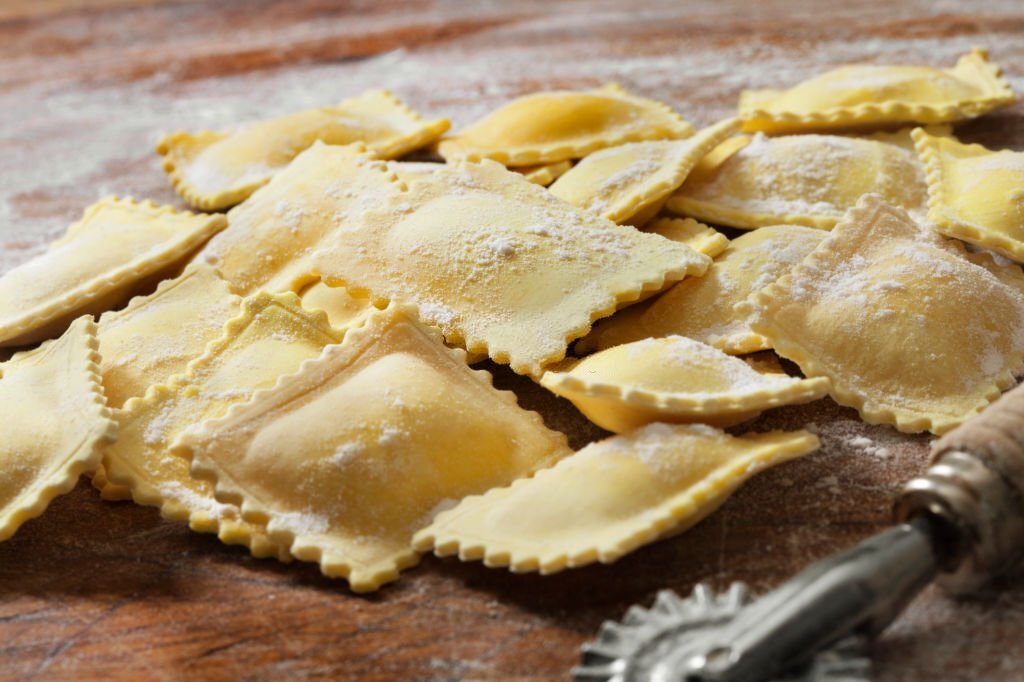
It’s impossible not to think about ravioli when talking about stuffed pasta. Ravioli is the most popular kind of stuffed pasta there is, and you can usually recognize it by its typical square or rectangular shape.
Ravioli comes from the Italian word “raviolo,” which means “to stuff.” It was first cooked in the 14th century in Italy! The earliest known mention of ravioli appears in the personal letters of Francesco di Marco Datini, a merchant of Prato in the 14th century.
Ravioli can be made from a variety of different doughs, including wheat flour, semolina flour, egg pasta dough, and even potato dough. The most common fillings for ravioli is ricotta cheese, spinach, nutmeg and black pepper, which was already the most popular recipe in Antique Rome!
Discover what makes the Tortellini so special
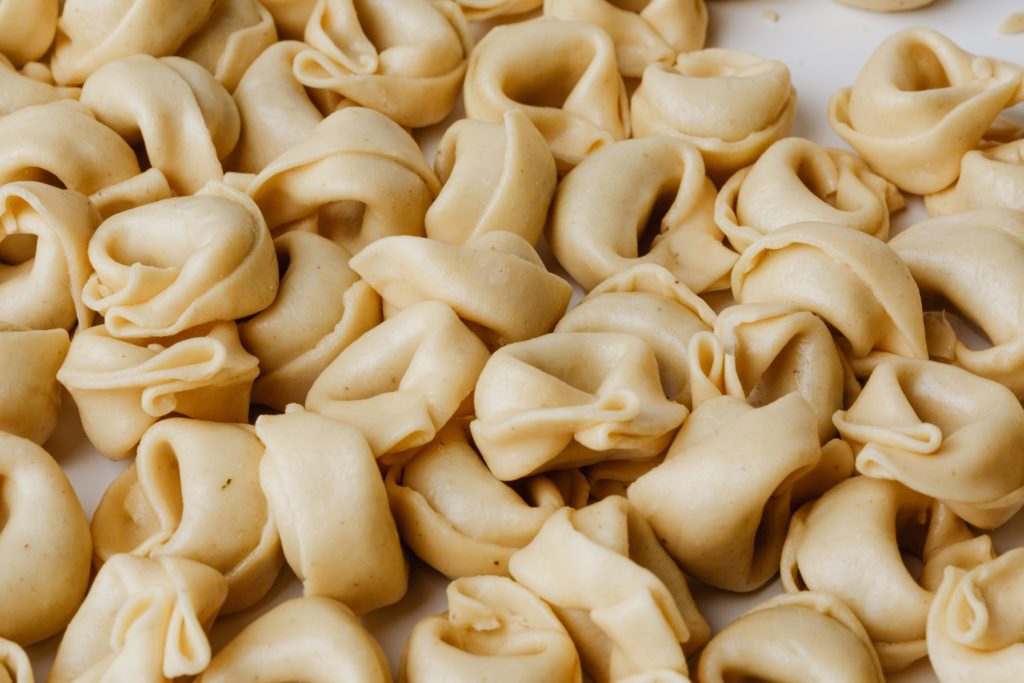
Tortellini is let’s say, the second most common Italian stuffed pasta. You usually recognise it with its small and circular in shape. Tortellini come from the Emilia-Romagna region of Italy, and the most common fillings for tortellini include cheese, meat, and vegetables.
Tortellini dough is typically made from wheat flour and eggs, and the dough is rolled out very thin. Once the dough is rolled out, small pieces of filling are placed in the center of each circle. The dough is then folded over the filling to form a half-moon shape and then sealed.
Italians usually eat tortellinis as a first course, and the dish is typically served with a broth or cream sauce.
Mezzelune, a typical stuffed pasta you should absolutely know about
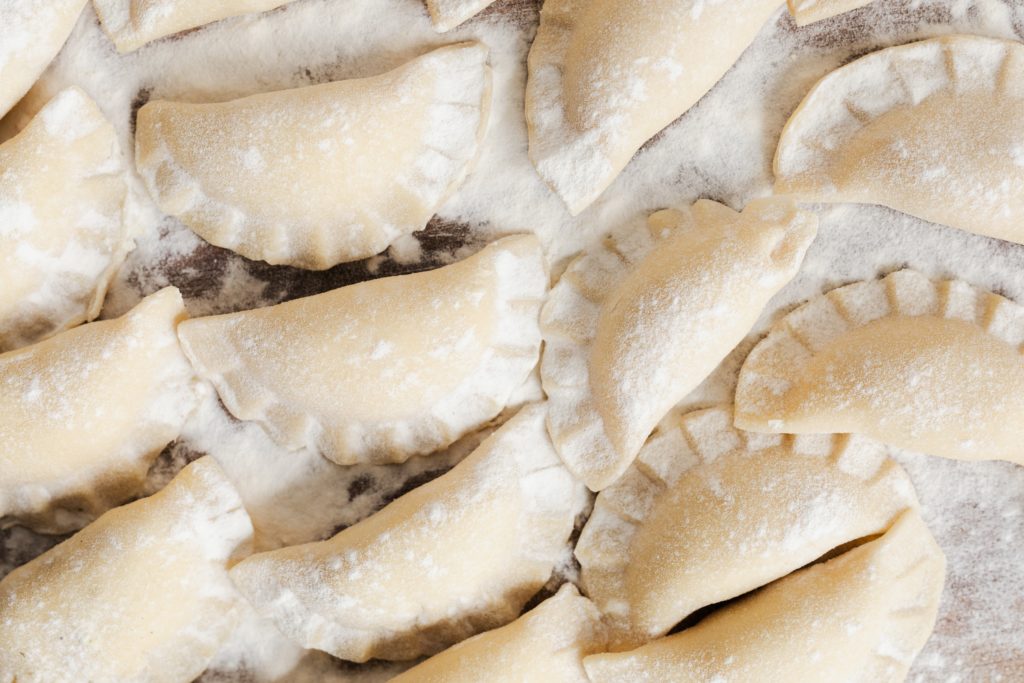
Mezzelune is also a type of pasta that is typically half-moon shaped. Instead of being “twisted” like the tortellini, it has more of a flat dimension like the ravioli, but in a crescent shape.
Mezzelunes come from the area of South Tyrol in Italy, but it is also a typical dish in Austria (where it is known as schlutzkrapfen). Common fillings include ingredients such as cheese, mushrooms, potatoes, meat, or spinach.
It is usually eaten as a first course, and paired with sauces like pesto, or ingredients like sausage or seafood.
Is Cannelloni a kind of stuffed pasta?
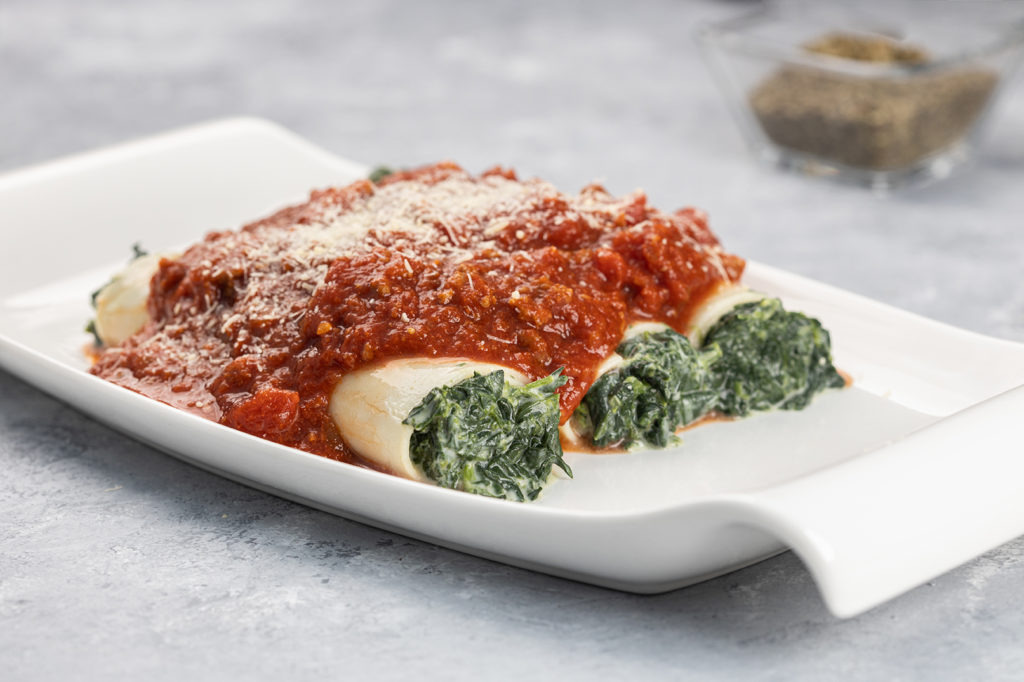
Cannelloni isn’t the typical Italian stuffed pasta, but by the way it is cooked – always with a sauce inside – you can consider it a cousin of typical stuffed pasta.
Indeed, the large and tube shape of the cannelloni allows it to be filled easily with a variety of different ingredients. Cannellonis come from the Campania region of Italy, and the most common fillings for cannelloni include cheese like parmesan or ricotta and meat like beef.
Cannellonis are usually baked with a tomato or cream sauce, and the dish is typically garnished with cheese and herbs.
In conclusion…
If you’re looking for a delicious and hearty dish, look no further than ravioli, tortellini, or mezzelune. These popular types of stuffed pasta are sure to please everyone at the table. And if you’re feeling adventurous, why not try cannelloni? No matter what type of stuffed pasta you choose, you’re in for a treat!
If you’re a pasta lover, you know it’s easy to cook more pasta than you actually need. In this case, you might want to save your delicious meal for later, and might wonder what’s the best way to keep it safe. If the fridge is a great option, you know you can only save your pasta for a short amount of time.
So, can pasta be frozen? This could be a great option indeed, and luckily, the answer to this question is a resounding yes! In fact, freezing pasta is a great way to keep it fresh and prevent it from going bad. But here’s a few tricks to know first in order to freeze your pasta safely. Let’s review them together and if you follow these simple tips, you’ll be able to enjoy delicious, fresh pasta any time you want!
Can cooked pasta be frozen?

When it comes to cooked pasta, freezing is definitely an option! However, there are a few things to keep in mind when freezing cooked pasta.
First of all, cooked pasta should be cooled completely before being frozen. Otherwise, the heat from the pasta will cause the temperature of the freezer to rise, which could lead to food spoilage.
It’s also important to make sure that the cooked pasta is properly sealed before freezing. This will help to prevent freezer burn and keep the pasta fresh. For instance, you can store them in a plastic tuperware, in individual portions or bigger ones.
Finally, cooked pasta should be eaten within 2-3 months of being frozen.
Can you freeze uncooked pasta?
Usually, most people won’t bother to freeze uncooked pasta, as dry pasta almost has a two-year shelf life in the package. It’s better in this case to keep your dry pasta boxes on your shelves instead of freezing them.
Fresh pasta, on the contrary, that has to be kept in your fridge, has a short expiration date. It can be useful to freeze it in order to keep it longer. In this case, you can keep fresh pasta in your freezer for up to 1 month. Just like cooked pasta, you should properly seal them before freezing in airtight bag or container.
Can you freeze cooked pasta with sauce?

You just cooked a delicious spaghetti carbonara or pasta with pesto, and you’d like to save the rest for later? There are a few things you need to know before you start tossing your noodles in the freezer.
After eating your pasta with sauce, allow the amount of pasta you want to freeze to cool completely before freezing.
When you’re ready to freeze your pasta, be sure to place it in an airtight container or bag. If you’re planning on freezing a large batch of pasta, be sure to label and date the container so you know how long it’s been in the freezer.
How do you reheat frozen pasta?
When you’re ready to enjoy your frozen pasta, there are a few different ways you can reheat it. The best way to reheat cooked pasta is by simmering it in sauce on the stovetop. Simply place the frozen pasta in a pot with your favorite sauce and heat over low heat until warmed through.
You can also reheat cooked pasta in the microwave. Simply place the frozen pasta in a microwave-safe dish and heat on high for 1-2 minutes, or with the de-freezing mode. Always put a bit of water in your container before reheating in the microwave to avoid sticky pasta.
If you’re reheating uncooked pasta, the best way to do it is by placing the frozen pasta in a pot of boiling water or broth and cook for 2-3 minutes, or until thawed. You can also reheat uncooked pasta in the microwave just like cooked pasta.
Whatever method you choose, be sure to reheat your pasta until it’s piping hot all the way through. This will help to prevent foodborne illness.
Now that you know how to freeze and reheat your pasta, you can enjoy delicious, homemade noodles anytime you want! Just be sure to follow these simple tips and you’ll be enjoying fresh pasta in no time.
Any Pasta Lover knows that when it comes to pasta, there are two main types: dry and fresh. But did you ever wander what’s really the difference between the two, and most important, which kind is the best? Let’s boil down a quick rundown on each type of pasta.
What’s the difference between fresh and dry pasta?
When it comes to nutrition, there really isn’t a huge difference between fresh and dry pasta. So how come you can find those two types of pasta at the supermarket? Let us explain you why.
Common characteristics of dry pasta
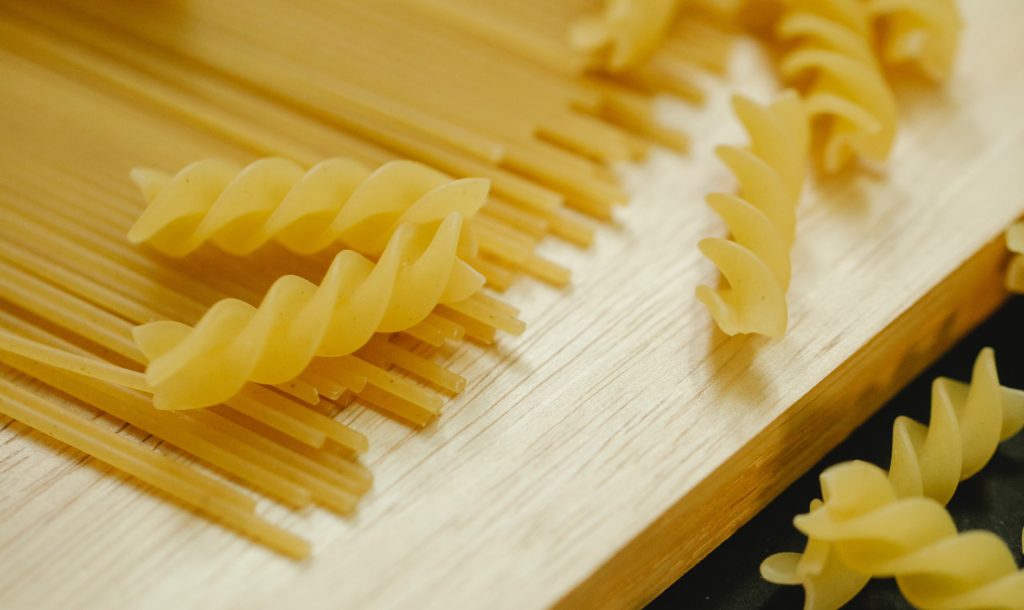
Dry pasta is the most common type of pasta. It’s made from durum wheat semolina and doesn’t contain any eggs. Dry pasta also has a lower moisture content than fresh pasta, so it will not become mushy when cooked. This means that the pasta needs to absorb water and will cook a bit slower.
Dry pasta comes in a variety of shapes and sizes, from long strands like spaghetti to small pieces like elbow macaroni. It is typically sold in boxes or bags, while fresh pasta is usually sold in refrigerated cases. It’s also available in whole wheat or gluten-free varieties.
To sum up, dry pasta is the most common type of pasta you can find, and also generally the cheaper. It’s quick and easy to cook, and can be used in a variety of dishes.
Common characteristics of fresh pasta

Fresh pasta is made from a dough of eggs and flour. It’s usually sold in the refrigerated section of the grocery store and has a shorter shelf life than dry pasta.
Fresh pasta comes in a variety of shapes and sizes, from long strands like fettuccine to small pieces like ravioli. It can be made from whole wheat or semolina flour, and is usually cooked for a shorter period of time than dry pasta.
Fresh pasta is less common, but is often seen as higher quality. It has a more delicate flavor and texture, and is best cooked quickly. It’s also more expensive than dry pasta.
Is there a difference of calories between fresh pasta vs dried pasta?
When it comes to nutrition, both types of pasta are relatively similar. A 2-ounce serving of dry spaghetti has about 200 calories and 42 grams of carbohydrates. A 2-ounce serving of fresh fettuccine has about 210 calories and 43.
As a general rule, you should plan on serving 2 ounces of pasta per person when cooking dry pasta and 4-5 ounces when cooking fresh pasta. This will give you enough pasta to enjoy without feeling overly full.
How do you cook fresh pasta?
Fresh pasta only takes a few minutes to cook, so it’s perfect for a quick weeknight meal. Simply bring a pot of water to a boil and add the pasta. Cook for two to three minutes, or until al dente. Drain the pasta, add your favorite sauce and there you go: you have a delicious fresh and comforting pasta meal to enjoy!
How do you cook dry pasta?
Dry pasta is typically cooked for about 10 minutes in boiling water. This duration depends on the type of dry pasta you choose (spaghetti, tortellini, penne) so it’s best if you refer to the cooking time written on the box.
It can be served with just about any sauce, but it’s especially good with tomato-based sauces. One or two basil leaves, a little of fresh grated parmesan and bon appétit!
In conclusion…
So, what’s the verdict? Both types of pasta have their pros and cons. It really comes down to personal preference. Do you prefer the heartiness of dry pasta, or the delicate flavor of fresh pasta? Whichever type you choose, enjoy!
Gnocchi may not be the prettiest pasta out there, but it’s definitely one of the tastiest! This traditional Italian dish made from potato is usually considered as a cousin of pasta, since its recipe differs quite a bit from traditional pasta. Easy to cook, great with sauces and never disappointing: discover everything there is to know about gnocchi, and why you should love it!
Where does gnocchi comes from?
While the origins of gnocchi are unclear, it is thought to have originated in the Middle Ages. Gnocchi is an Italian dish that has been around for centuries. It was likely created as a way to use up leftover potatoes. Potatoes were not widely consumed in Europe until the 16th century, so gnocchi may have been one of the first dishes to use them as a main ingredient.
The dough is made from boiled potatoes, flour, and eggs. It is then rolled into small balls and boiled.
Gnocchi is often considered a comfort food, as it is hearty and filling. And if you have tried it once, we think you can pretty much agree! Many people think of gnocchi as being similar to pasta, but there are some key differences.
Gnocchi vs regular pasta: what’s the difference?
Gnocchi is made from potatoes, flour, and eggs, while pasta is made from wheat flour and water. Gnocchi is denser and chewier than pasta, and has a slightly different nutritional profile. It also contains more calories and carbohydrates than pasta, but less protein. Both gnocchi and pasta are low in fat and sodium.
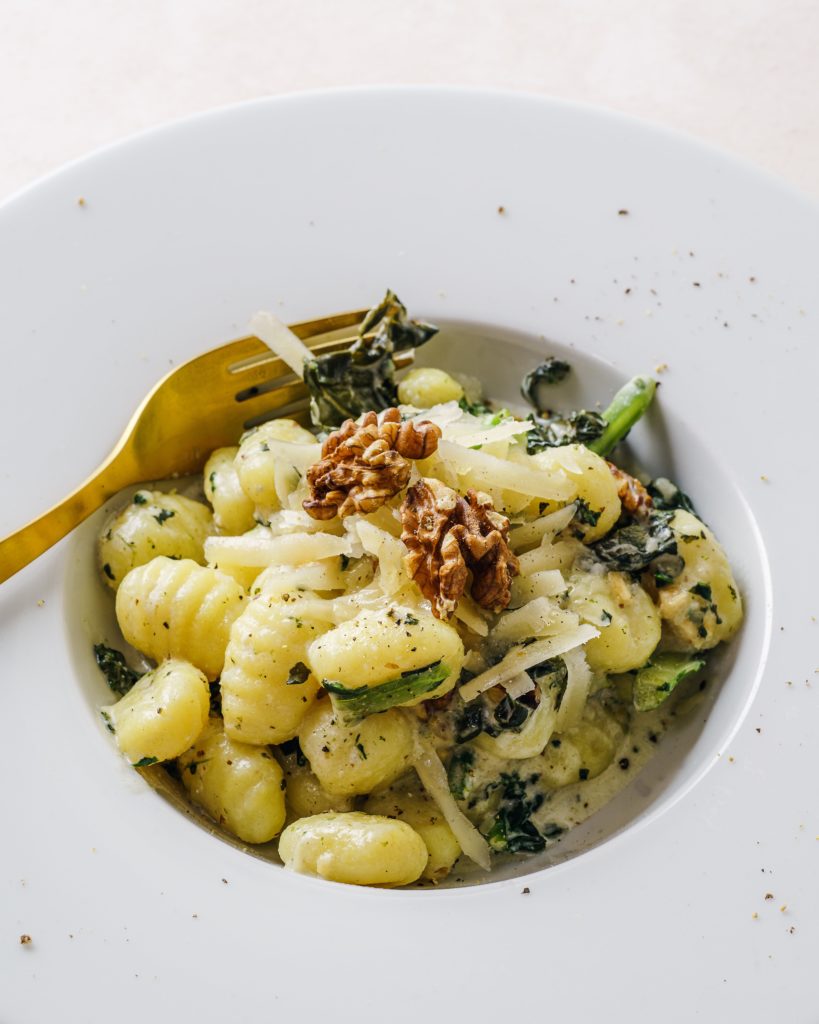
The ingredients and texture are different, but so is the shape: while pasta comes in a variety of shapes, gnocchi is always known as a small oval ball. Usually, a fork is used to create stripes in the balls, which gives it even more texture.
While gnocchi and pasta both have their place in a healthy diet, gnocchi may be the better choice if you’re looking for something more filling and satisfying. Gnocchi is also a good option for those who are on a gluten-free diet, as it is made without wheat flour. If you’re looking for a lighter pasta dish, however, pasta is the way to go. Whichever you choose, enjoy!
The traditional gnocchi recipe
Really, gnocchi is the easiest pasta to make! The traditional dough of gnocchi is made from 3 ingredients only:
- Potatoes
- Flour
- Eggs
Start peeling and cutting your potatoes in half to boil them quicker. Once they are boiled, take them out of the water and smash them into a nice purée. Add flour and eggs to the mix, until obtaining a nice chewy texture. Usually, you might want to use your hands at the end to feel the texture better!
On a floured countertop, roll your gnocchi dough into a long thin “snake” shape. Cut the dough every 1,5 inches. Squeeze those small bites into your hands to obtain an oval shape. You can also roll them with a fork to give them those nice traditional stripes.
Boil in salted water until the gnocchis float on the surface: it usually just takes a few minutes! And voilà! You have delicious homemade gnocchis to eat with whatever sauce you want.
How to jazz it up a bit…
While the traditional gnocchi recipe is fairly simple, there are many ways to jazz up this dish.
First, you can choose to cook sweet potatoes gnocchi for a sweeter and tastier meal.
You can add different herbs and spices to the dough, or top the gnocchi with cheese or bacon. There are endless possibilities when it comes to recipes for gnocchi, so get creative and experiment until you find your perfect version!
What are some common ways to enjoy gnocchi?
There are many ways to enjoy gnocchi, but some of the most popular include pairing it with a tomato sauce, pesto, or cream sauce. Gnocchi can also be baked or fried, and served as a side dish or main course. No matter how you enjoy it, gnocchi is a delicious and versatile pasta option.
Why you should give this ugly duckling of a pasta a chance!
If you haven’t had gnocchi before, or if you’re not a fan of the traditional pasta options, then you should definitely give this unique pasta dish a try. Plus, it’s delicious! So if you’re looking for something new and different, give gnocchi a chance. You won’t be disappointed.
The answer is, it depends, it depends on the kind of dough, the kind of filling (if we are talking about stuffed pasta) and the sauce that goes with it.
In a moment we will dive into each one of those three key points one by one, but let’s just say that even though not all pasta is vegan, there sure are plenty of vegan options in the pasta world!
Is pasta dough vegan?
Most pasta dough is made with wheat flour, water, salt and olive oil. So yes, those doughs are vegan, and even PETA says so. However, some recipes may also include eggs. This is the only time when pasta dough might become problematic if you are trying to follow a strictly vegan diet.
The good news is eggs can always be replaced for some other kind of plant-based fat such as olive oil. This might take a little bit of experimenting to find the right amount, but as a rule of thumb 1 tablespoon of olive oil will replace 3 whole eggs.
A good dough recipe is like a delicate formula and modifying might not be as easy as it sounds though. 1 tablespoon of olive oil might replace 3 whole eggs in terms of fat, but will it allow us to achieve the same texture? We might need to also add some water to the mix in order to valance things out. If you are an experienced cook and are comfortable trusting your intuition in the kitchen then go for it, otherwise I recommend you find a pasta dough recipe that contain vegan-friendly ingredients from the start.
It’s worth noting that some brands of wheat flour are processed using animal-based products. For example, Bob’s Red Mill admits on its website that some of its products are “processed on equipment that also processes milk, tree nuts, soy, and wheat. So if you’re a vegan who’s concerned about cross-contamination, it’s best to choose a brand of wheat flour that is certified vegan.
Is pasta filling vegan?
If you are thinking about industrial stuffed pasta then most of the times the answer to this question will be no. Store-bought stuffed pasta will, almost always, contain animal-based ingredient. Of course, there are some specialized brands offering vegan-friendly stuffed pasta, but unless they are vegan certified (and they will usually advertise this prominently) you can assume of-the-shelve stuffed pasta is not vegan.
But if you want to make your own, that’s a whole other story. Pasta filling recipes are much more permissive than pasta dough. There are no rules as for what stuffed pasta should be filled with, it can literally be anything you want! Mash up some veggies and mix them with some nuts and you’ll have a delicious, 100% vegan filling for your stuffed pasta.
Your imagination is the limit, and most of the times you can probably take inspirations from other recipes you like and make them into pasta filling. Tofu, arrowroot, seaweed, plant based cheeses… those are all candidates to make a great vegan filling for your pasta.
Are pasta sauces vegan?
Traditional pasta sauces, the ones we all know by name such as Bolognese, Carbonara, Pesto, Alfredo sauce… all contain meat, cheese or milk, which mean they are not suit for a vegan diet. If you want to taste those without breaking your diet you will have to look for substitutes. Parmesan cheese substitutes, plant-based milks and creams, plant-based meat, etc. The good news is there are plenty of already made recipes which have replaced these ingredients achieving incredible results, most of the time indistinguishable form the original, or even better!
Also, just like with the pasta fillings, there aren’t any written rules about what is or isn’t a good pasta sauce. Sometimes simply sautéing your pasta with some vegetables and olive oil will be more than enough to get a delicious, healthy, 100% vegan sauce. Or mix some non-dairy yogurt with some mushrooms and spices if you are looking fore something creamier.
Other types of pasta
There are also other types of pasta which are not the traditional Italian, some originate from other cultures, others from innovative chefs pushing the boundaries, but all of them vegan-friendly or easy to adapt to fit a 100% truly vegan diet. Take a look at these alternative types of pasta, I’m sure they’ll also inspire you!
I know what you are thinking. How can pasta not be made from pasta? Well, when we think of pasta we mostly picture the traditional Italian pasta and their sauces. Spaghetti Bolognese, pene a la Carbonara, linguini al pesto, ravioli, tortellini…
The dough for all these pastas is usually made with wheat flour, water, salt, olive oil and eggs. But you may want to enjoy pasta while avoiding some of these products for a number of reasons. Maybe you are allergic or intolerant to one or more of those ingredients, you might be following a vegan diet, or you might simply want to experiment and expand your culinary horizons with new flavors and cooking techniques.
Whatever your reasons, there are a series of pastas which are not made following the traditional Italian recipes. Some of these alternative forms of pasta have their origin in other cultures which might historically not have had access to those ingredients but instead had an abundance of others. Others have been born more recently, directly from the minds of innovative chefs looking to mix things up and surprise us with new textures and flavors.
Let’s take a look at some of the most popular alternative forms of pasta.
Rice pasta
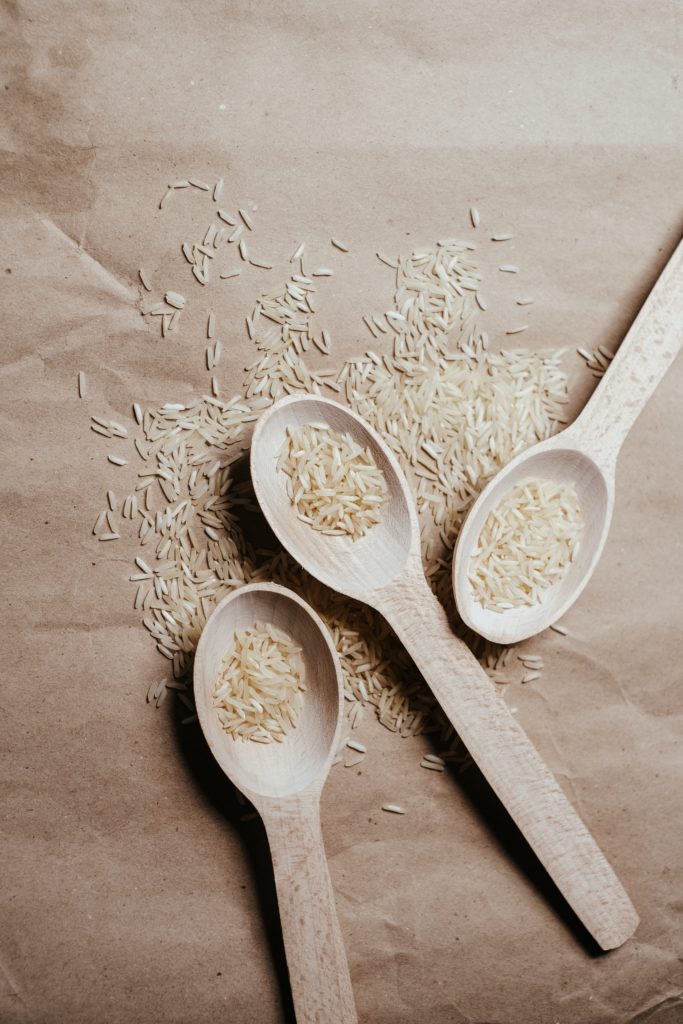
Rice pasta is a gluten-free alternative to traditional wheat pasta. It is made from rice flour and water, and is available in a variety of shapes and sizes. Rice pasta is a good source of complex carbohydrates and fiber, and is also lower in calories than traditional pasta.
With its mild flavor and firm texture, rice pasta can be used in a variety of recipes, including soups, casseroles, and stir-fries. If you’re looking for a gluten-free pasta option, rice pasta is a great choice.
Rice pasta is a big part of traditional cuisine in may parts of the world, especially Asia. There are many different theories about the origins of rice pasta. One of the most accepted suggests that it was first developed in China, but there is no real consensus about it, and it might just be that we attribute it to China because of how popular this type of pasta has become in their traditional cuisine over time.
Quinoa pasta
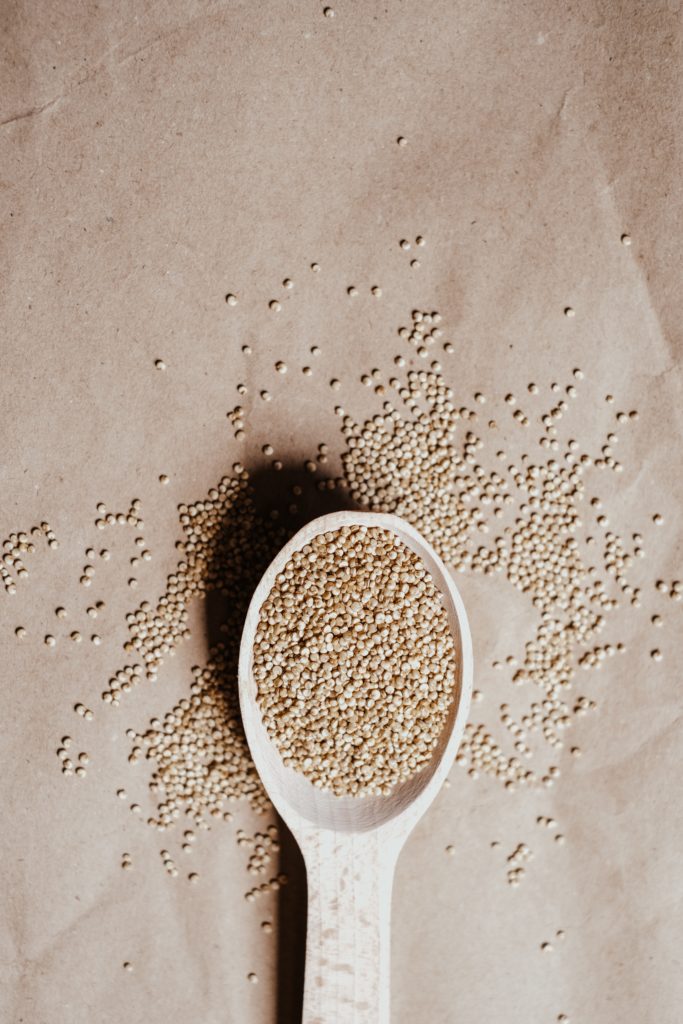
Quinoa pasta is made from quinoa flour, which is a gluten-free grain that is native to South America. Quinoa has been cultivated for centuries in the Andes Mountains and was a staple food of the Inca civilization. The quinoa plant produces small, round seeds that are similar in appearance to couscous or rice. When quinoa flour is combined with water and kneaded, it forms a sticky dough that can be used to make pasta.
If you’re looking for a delicious, nutritious alternative to traditional pasta, quinoa pasta is a great option. Made from 100% whole grain quinoa, this pasta is packed with protein and fiber, and is gluten-free. Quinoa pasta has a light, fluffy texture and a slightly nutty flavor that pairs well with a variety of sauces and seasonings. Plus, it’s quick and easy to cook, making it a perfect weeknight meal. Give quinoa pasta a try the next time you’re looking for a healthy, delicious pasta option!
Bean pasta
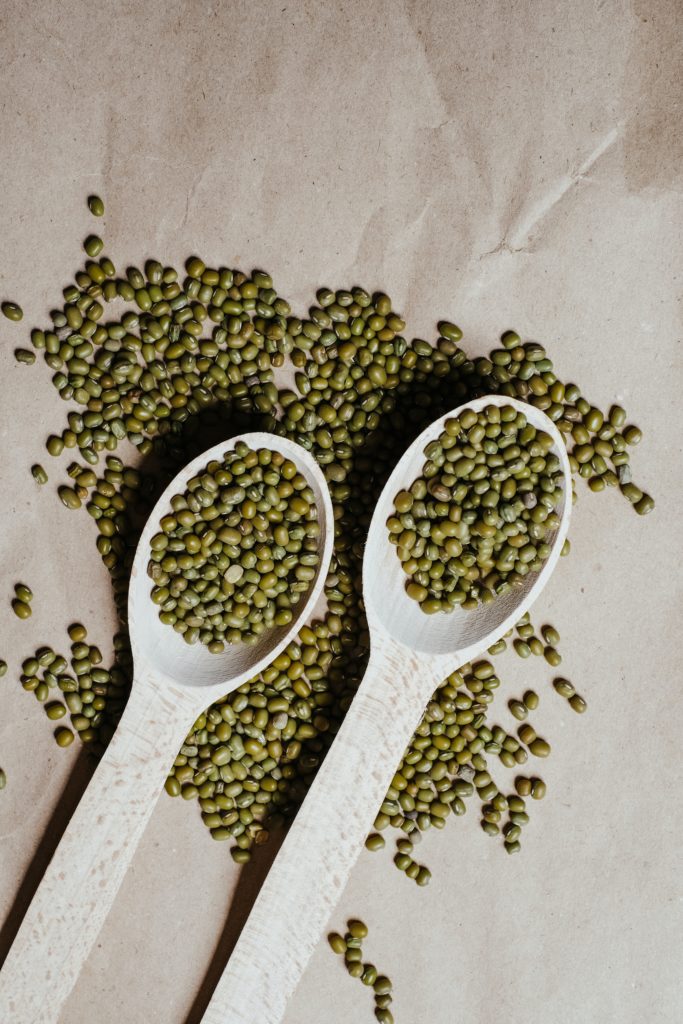
Bean pasta is usually made from a mixture of different types of beans, such as cannellini beans, chickpeas, and lentils. The beans are ground into a flour and then mixed with water to form a dough. The dough is then extruded through a pasta machine to create the desired shape.
It is a staple food in many parts of the world, especially in Italy, and is not new by any stretch of the imagination. It was first mentioned in a cookbook from the 14th century, and the first known recipe for bean pasta was published in the 16th century.
It is a healthy alternative to traditional pasta made from wheat flour, it is high in protein and fiber, and it is gluten-free. It is also a good source of iron and folate. Bean pasta can be used in any recipe that calls for pasta, such as spaghetti, lasagna, or macaroni and cheese. Overall, a great choice for those who are looking for a healthy alternative to traditional pasta.
Veggie pasta
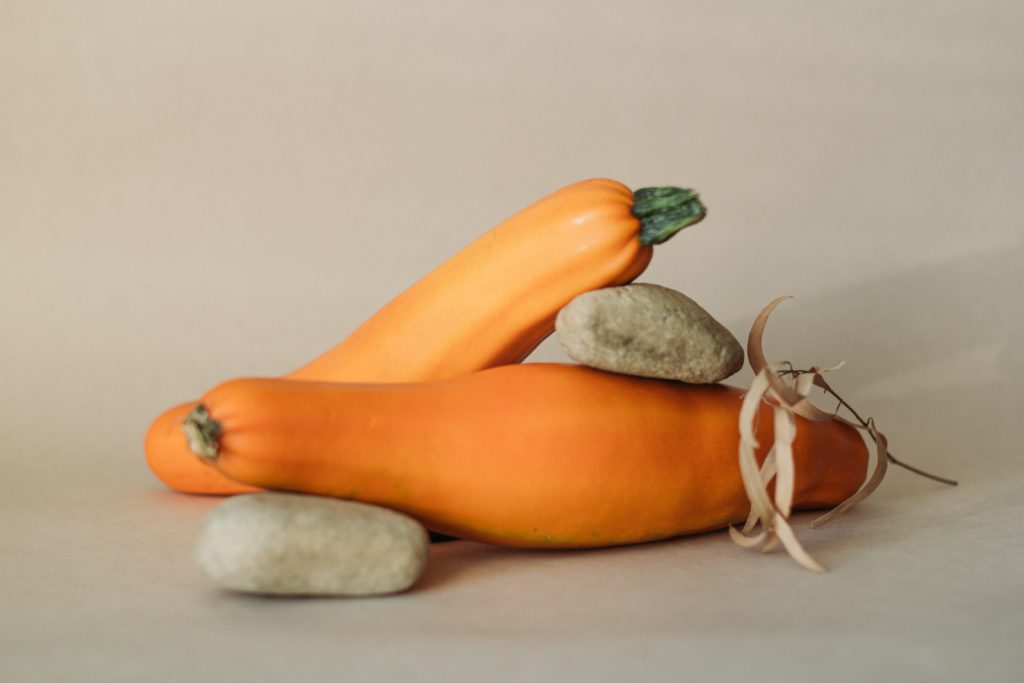
To be fair, calling veggie pasta, pasta, is a stretch. Unlike the other pasta alternatives which kind of followed a similar recipe, replacing some ingredients, veggie pasta only resembles pasta in its shape.
Veggie pasta is actually pure vegetables. Using a special type of shredded vegetables such as zucchinis or carrots are given a spaghetti-like shape and then cooked as such, even with traditional sauces such as pesto.
Even though veggie pasta is further away from what we know as pasta, it is still great option to spice up your diet or get the kids to eat their vegetables in a fun way!
What kind of “pastas” will come next?
There you have it! A whole world of pasta which are not your traditional pasta. Of course, you also have different varieties, like gnocchi made out of potatoes, or stuffed pasta that also differ from the regular dry pasta. And, with the popularity of pasta and Italian food in general around the world, I’m sure chefs and cooking enthusiasts will keep experimenting and we will see more pasta alternatives becoming popular in the next few years.
If you have any favorite recipe of your own of “non-pasta”, feel free to share it in the comments section below!

